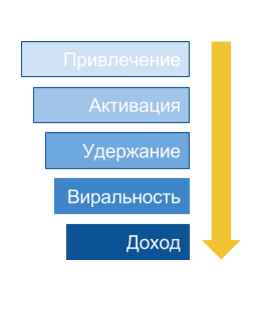Lecture 2 of 10. Seven types of hypotheses
- Tutorial

For fast growth, Internet companies need to test hypotheses. Hopox can be used to organize experiments and relate team actions to analytic data . However, he himself will not come up with hypotheses.
Below we will analyze seven types of hypotheses, so that it is clear in which direction to conduct experiments.
Today there will be many cases. Go straight to the point.
Experiments can be with attracting channels, sales funnels, monetization, user behavior, ways to recommend a product, mechanisms for retaining active customers, resurrecting abandoned customers, etc.
The areas of experimentation can be divided using the “Pirate Metrics” by Dave McClure: Attraction, Activation, Retention, Virality, Income. These five steps describe the path of the user who is able to give maximum value to the business.

1. Attraction hypotheses
- hypotheses testing channels of attraction to the product.
We are constantly changing something in the channels of attraction. However, now all actions are tied to the results in numbers. Depending on the channel, actions may vary greatly, but the key metrics for success are the number of impressions, audience reach, and the number of clicks to the site.
Examples by channels:
Contextual Advertising:
- “If you change the quick links in the ad, then increase the CTR by 2%”,
- “If you connect a bet broker, the cost of the transition will decrease by 20%”
- “If we add a price to the ad, we will get a solvent audience, increase the cost of attracting a user to 25 rubles, but the conversion to purchase on the site will grow to 7%”
SMM:
- “If we do a post-interview with a well-known market expert, we get more than 200 reposts”
- “If you make one humorous post per day, then we will increase the number of subscribers in two weeks by 400 people”
Email Marketing:
- “If we change the heading in the letter, we will get more than 60% conversion into the read letters”
- “If we offer a discount on the 20th day after activation, we’ll get a conversion of 15% to the purchase page”
Hypothesis: If you add numbers to the heading of the article and instead of “Simple test that increased the number of our subscribers” publish “Simple test that increased the number of our subscribers by 30%”, then we increase the number of subscribers by 40%.
Alex Turnbull, Groove - SaaS-service that implements helpdesk-solutions for small businesses.
2. Activation hypotheses
- hypotheses for testing the first successful user experience.
Hypothesis success metrics: Number of pages viewed for content projects, filling out a profile for SaaS, adding to the cart, but most often it is the visitor’s email.
Hypothesis: “If you remove one of the four fields in the activation form, the conversion will increase by 26%.”
This is the real case of Neil Patel, a well-known marketer and founder of QuickSprout, Kissmetrics, CrazyEgg and Hello Bar.
3. Retention hypotheses
- growth hypotheses on creating the habit of using a product and service.
It is important to know that a 5% increase in retention increases profits by an average of 25-95%. Later there will be a separate lecture on retention hypotheses with a description of the universal mechanism. In the meantime, one familiar case.
Hypothesis: “If you notify users each time by email that someone marked him in the photo, then the CTR will be about 75%,” Facebook.
4. Hypothesis of virality
Hypotheses on attracting new customers using existing ones. There are three types of virality: built-in, artificial and word of mouth. But more about that in the following lectures, but for now a couple of cases from the king of virality DropBox: the
functionality of inviting friends from social networks, via email and importing contacts gave 3 million sent invitations within the first 30 days after launch.
a referral program that allows you to increase the volume of your drive for inviting a friend, contributed to the growth of the audience by 60%
5. Monetization hypotheses
Hypotheses test how to efficiently translate active users into paying customers.
Hypothesis: “If we reduce the trial version from 30 to 14 days, then we will increase the conversion into sales at the end of the trial by 102%.”
QuickSprout Case
6. Value hypotheses
Eric Ries assigns all five of these types to growth hypotheses, which are aimed at product development. He also identifies a large pool of hypotheses for business development - value hypotheses.
Value hypotheses test the relevance of value propositions for different segments. These hypotheses are relevant for startups and companies with a new product and they will not be discussed in these lectures.
7. Management hypotheses
Hypotheses related to focusing a team for a long time around one key metric.
- “If we use hopox and start experimenting, we will be able to attract another +1000 customers per month from existing channels”
- “If we hire another content manager, we’ll increase the number of subscribers in 3 months by 2000”
Homework:
Try to create a minimum of 10 hypotheses in the hopox marketing tool , 2-3 for each direction of business development: Attraction, Activation, Retention, Virality, Monetization.
Lecture list:
- Experiment and grow
- 7 types of hypotheses
- Growth Team Work
- Attraction Hypotheses and Values
- Data Based Work
- Activation hypotheses
- Retention hypotheses
- Virality hypotheses
- Hypothesis Memo
- What have I withheld.
